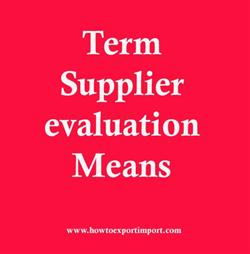What is Supplier evaluation
This post explains about Supplier evaluation.
Supplier evaluation:
Supplier evaluation is a term used in day to day business and refers to the process of Selecting and approving potential suppliers by quantitative assessment. The purpose of supplier evaluation is to ensure a portfolio of best in requirement supplies available for use. Supplier evaluation is also a process applied to current suppliers in order to measure and monitor their performance for the purposes of reducing costs, mitigating risk and driving continuous improvement.
 Supplier evaluation is a term used in business and refers to the process of evaluating and approving potential suppliers by quantitative assessment.
Supplier evaluation is a term used in business and refers to the process of evaluating and approving potential suppliers by quantitative assessment.
supplier a continual process within purchasing departments and forms part of the pre-qualification step within the purchasing process, although in many organizations it includes the participation and input of other departments and stakeholders. Most experts or firms experienced in collecting supplier evaluation information prefer doing so using five-step processes for determining which to approve. Their processes often take the form of either a questionnaire or interview, sometimes even a site visit, and include appraisals of various aspects of the supplier's business including capacity, financials, quality assurance, organizational structure and processes and performance. Based on the information obtained via the evaluation, a supplier is scored and either approved or not approved as one from whom to procure materials or services. In many organizations, there is an approved supplier list (ASL) to which a qualified supplier is then added. If rejected the supplier is generally not made available to the assessing company's procurement team. Once approved, a supplier may be re-evaluated on a periodic, often annual, basis. The ongoing process is defined as supplier performance management.
Evaluation Tools
Some of the challenges associated with supplier evaluation may be mitigated by the use of appropriate tools. For simple projects a spreadsheet can be used. But as evaluations become more complex or more frequent data management and data integrity issues become significant. Web Electronic RFP / Tendering systems are often used for initial selection projects. Some products provide functionality for combining both initial selection and ongoing evaluation and benchmarking.
Wider, within established procurement teaching, the Carter 10Cs model is an . This model looks at aspects which should be evaluated before contracting and as part of the ongoing supplier performance appraisal. The Cs are:
- Capacity (Does the organization have the capacity to deliver the order)
- Competency (Is the organization, its people or its process competent)
- Consistency (Does the organization produce a consistent output)
- Control of process (Can the organization control its process and offer flexibility)
- Commitment to Quality (Does the organization effectively monitor and manage quality)
- Cash (Has the organization got a strong enough financial base)
- Cost (Is the product or service offered at a competitive price)
- Culture (Are the supplier and buyer cultures compatible)
- Clean (is the organization ethical, funded legitimately, doesn't engage Child labor, etc.)
- Communication efficiency (Does the organisation have support technology of information integration) to support collaboration and co-ordination in the supply chain.
Other metrics that organizations increasingly start to measure vendor includes: conformance to the government regulations, usability, cultural fit and CEO approval rating. These metrics are placed into a table and weighted according to how importance is that metric to the organization.
The information on Supplier evaluation is detailed above. Comment below your thoughts on Supplier evaluation.
Learn Exports Imports Free, Click here
Click here to know GST rate of your goods or service
How is time of supply accounted under GST Tax Calculation
Valuation of GST under special cases
Valuation of GST Taxable supply
When to pay GST for supply of services?
When to pay GST?
GST on short supplied goods and services by nature
Impact of GST on imports in India
Applicable import duty after GST implantation
How to calculate IGST under imports?
Changes in IEC after GST
Linking IEC with GSTIN in customs
Meaning of Unjust enrichment
Meaning of term Taxable Territory under GST
What is Taxable supply under GST
Term Taxable Turnover under GST
Term Two Rate Structure under GST
Unique Transaction Reference number (UTR) Means
Term Treatment for Zero Rated Supplies under GST
Transportation of goods without issue of invoice under GST
Why demurrage/detention waiver period is required at destination for import
Why do carriers balance weight and volume while charging freight amount in Exports?
Why does Palletization require?
Why labeling and marking in Export business?
The term FCL. What is FCL means
The term LCL. What does LCL mean?
Tips to exporters on Documentation
How does First Appraisement system of import customs clearance procedures work?
How does Letter of Credit work?
How to export from India to Costa Rica?
Documents required for Export from Costa Rica
Customs procedures for Costa Rica Export
Registration required to export from Costa Rica
Import Customs processes in Costa Rica
Import Registration and import Licence procedures in Costa Rica
How to export from Bolivia?
How to Import to Bolivia?
How to import to India from Bolivia?